Analysis of Risk Management and Disclosure in Accounting Projects
VerifiedAdded on 2020/05/11
|30
|7136
|126
Report
AI Summary
This report provides a comprehensive analysis of risk management and risk disclosure in accounting, addressing the importance of these aspects in the current financial landscape. It explores the uncertainties of the modern economic environment and the impact of financial crises on organizational practices. The study examines the roles of accounting standard boards such as AASB, IASB, and IASC in risk disclosure for investors. It investigates the significance of risk reporting, the quality of disclosures, and the application of risk management theories. The report reviews literature on risk disclosure, investment uncertainty, and the impact of risk culture on organizational decision-making. It also covers the importance of risk disclosure for investors, risk management efficiency, and the role of various risk types. The research employs a qualitative method, utilizing secondary data and thematic analysis to assess the identified issues, offering insights into the importance of risk disclosure for investors and the effectiveness of risk management practices in controlling investment-related risks.
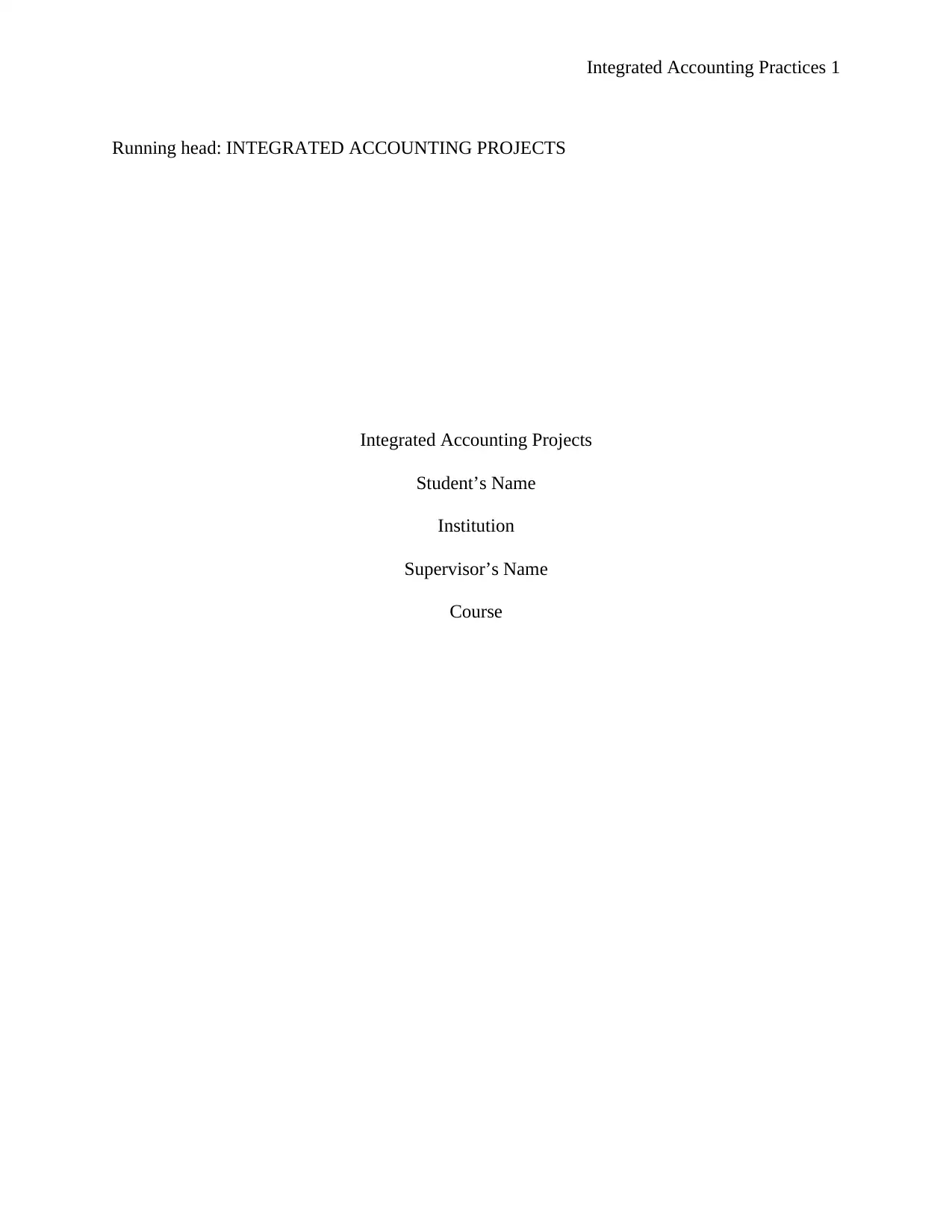
Integrated Accounting Practices 1
Running head: INTEGRATED ACCOUNTING PROJECTS
Integrated Accounting Projects
Student’s Name
Institution
Supervisor’s Name
Course
Running head: INTEGRATED ACCOUNTING PROJECTS
Integrated Accounting Projects
Student’s Name
Institution
Supervisor’s Name
Course
Paraphrase This Document
Need a fresh take? Get an instant paraphrase of this document with our AI Paraphraser
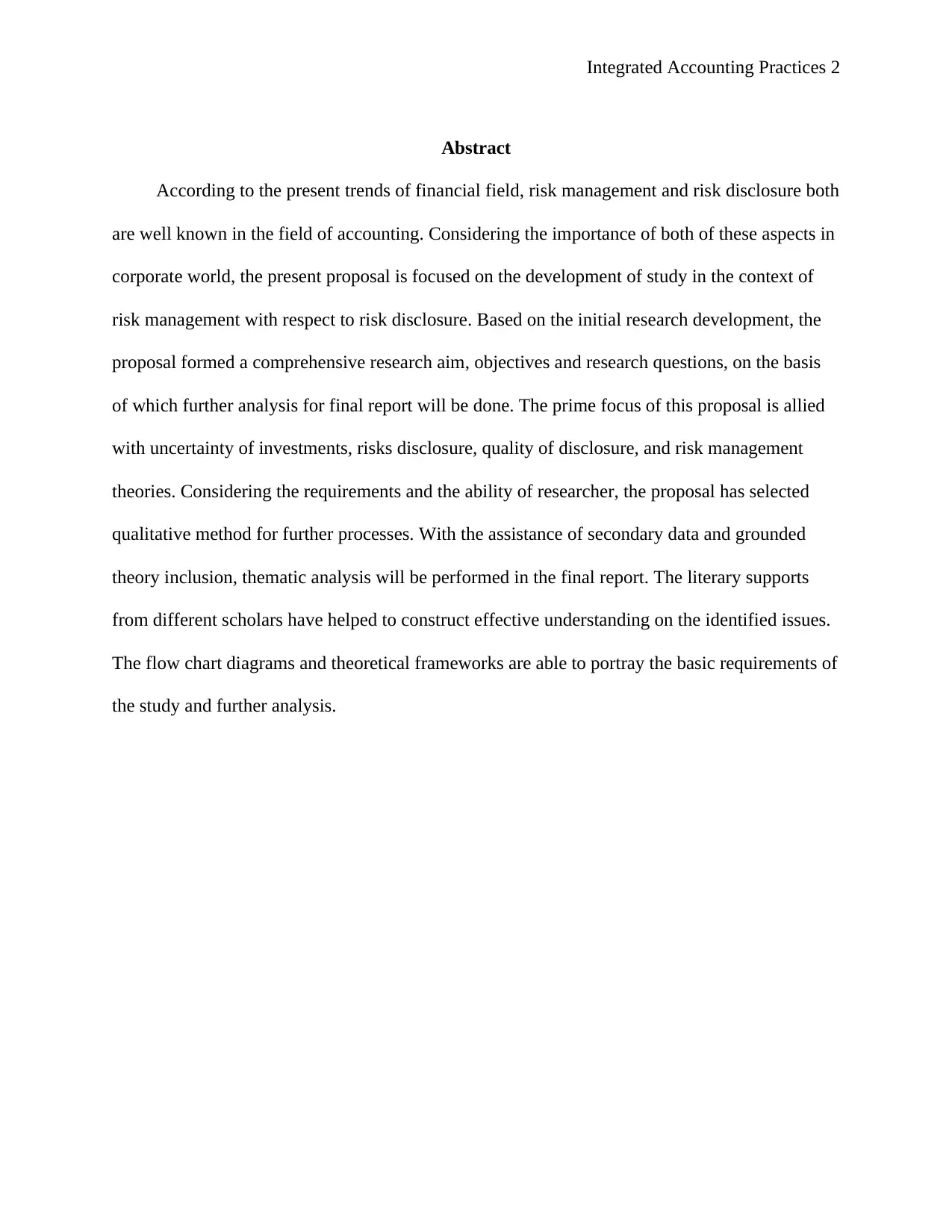
Integrated Accounting Practices 2
Abstract
According to the present trends of financial field, risk management and risk disclosure both
are well known in the field of accounting. Considering the importance of both of these aspects in
corporate world, the present proposal is focused on the development of study in the context of
risk management with respect to risk disclosure. Based on the initial research development, the
proposal formed a comprehensive research aim, objectives and research questions, on the basis
of which further analysis for final report will be done. The prime focus of this proposal is allied
with uncertainty of investments, risks disclosure, quality of disclosure, and risk management
theories. Considering the requirements and the ability of researcher, the proposal has selected
qualitative method for further processes. With the assistance of secondary data and grounded
theory inclusion, thematic analysis will be performed in the final report. The literary supports
from different scholars have helped to construct effective understanding on the identified issues.
The flow chart diagrams and theoretical frameworks are able to portray the basic requirements of
the study and further analysis.
Abstract
According to the present trends of financial field, risk management and risk disclosure both
are well known in the field of accounting. Considering the importance of both of these aspects in
corporate world, the present proposal is focused on the development of study in the context of
risk management with respect to risk disclosure. Based on the initial research development, the
proposal formed a comprehensive research aim, objectives and research questions, on the basis
of which further analysis for final report will be done. The prime focus of this proposal is allied
with uncertainty of investments, risks disclosure, quality of disclosure, and risk management
theories. Considering the requirements and the ability of researcher, the proposal has selected
qualitative method for further processes. With the assistance of secondary data and grounded
theory inclusion, thematic analysis will be performed in the final report. The literary supports
from different scholars have helped to construct effective understanding on the identified issues.
The flow chart diagrams and theoretical frameworks are able to portray the basic requirements of
the study and further analysis.
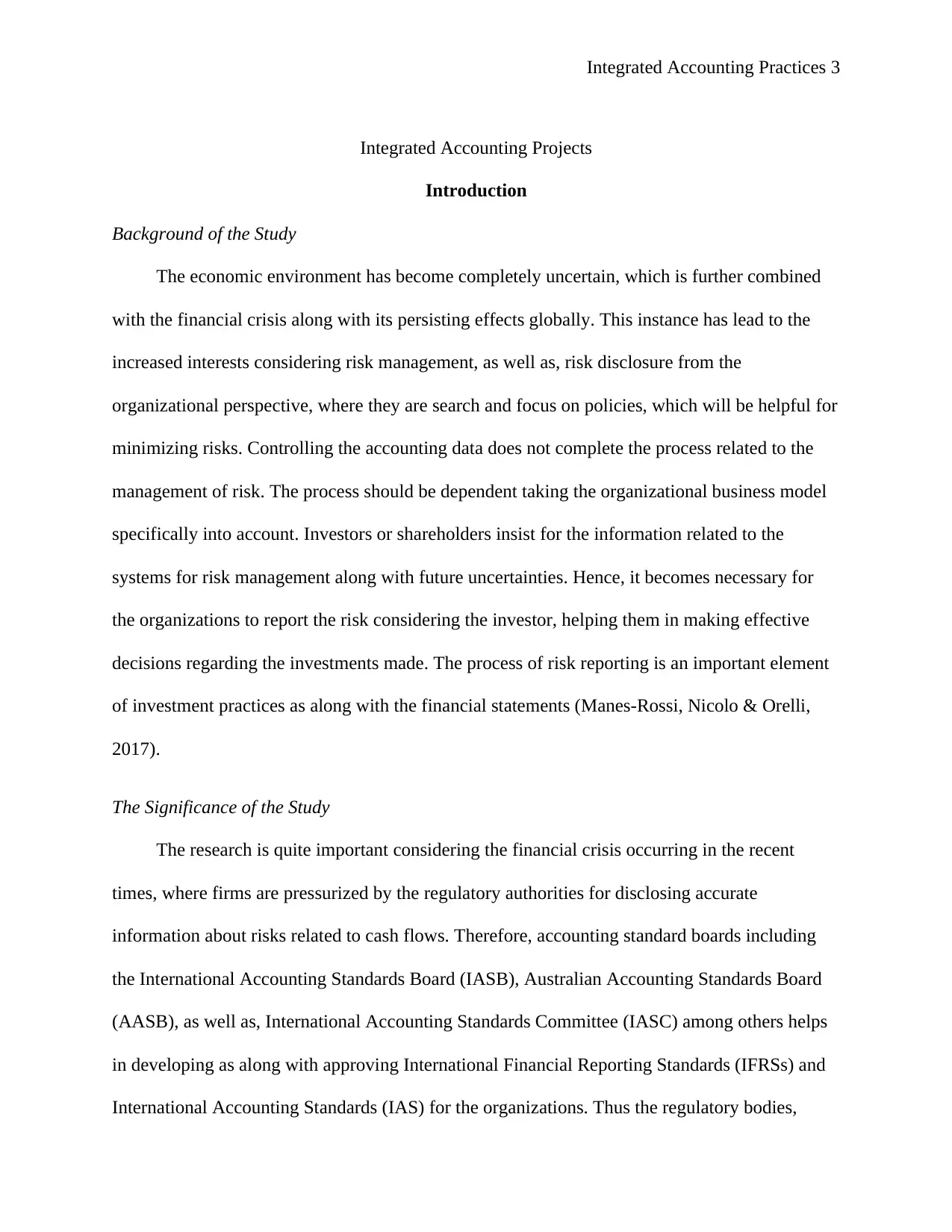
Integrated Accounting Practices 3
Integrated Accounting Projects
Introduction
Background of the Study
The economic environment has become completely uncertain, which is further combined
with the financial crisis along with its persisting effects globally. This instance has lead to the
increased interests considering risk management, as well as, risk disclosure from the
organizational perspective, where they are search and focus on policies, which will be helpful for
minimizing risks. Controlling the accounting data does not complete the process related to the
management of risk. The process should be dependent taking the organizational business model
specifically into account. Investors or shareholders insist for the information related to the
systems for risk management along with future uncertainties. Hence, it becomes necessary for
the organizations to report the risk considering the investor, helping them in making effective
decisions regarding the investments made. The process of risk reporting is an important element
of investment practices as along with the financial statements (Manes-Rossi, Nicolo & Orelli,
2017).
The Significance of the Study
The research is quite important considering the financial crisis occurring in the recent
times, where firms are pressurized by the regulatory authorities for disclosing accurate
information about risks related to cash flows. Therefore, accounting standard boards including
the International Accounting Standards Board (IASB), Australian Accounting Standards Board
(AASB), as well as, International Accounting Standards Committee (IASC) among others helps
in developing as along with approving International Financial Reporting Standards (IFRSs) and
International Accounting Standards (IAS) for the organizations. Thus the regulatory bodies,
Integrated Accounting Projects
Introduction
Background of the Study
The economic environment has become completely uncertain, which is further combined
with the financial crisis along with its persisting effects globally. This instance has lead to the
increased interests considering risk management, as well as, risk disclosure from the
organizational perspective, where they are search and focus on policies, which will be helpful for
minimizing risks. Controlling the accounting data does not complete the process related to the
management of risk. The process should be dependent taking the organizational business model
specifically into account. Investors or shareholders insist for the information related to the
systems for risk management along with future uncertainties. Hence, it becomes necessary for
the organizations to report the risk considering the investor, helping them in making effective
decisions regarding the investments made. The process of risk reporting is an important element
of investment practices as along with the financial statements (Manes-Rossi, Nicolo & Orelli,
2017).
The Significance of the Study
The research is quite important considering the financial crisis occurring in the recent
times, where firms are pressurized by the regulatory authorities for disclosing accurate
information about risks related to cash flows. Therefore, accounting standard boards including
the International Accounting Standards Board (IASB), Australian Accounting Standards Board
(AASB), as well as, International Accounting Standards Committee (IASC) among others helps
in developing as along with approving International Financial Reporting Standards (IFRSs) and
International Accounting Standards (IAS) for the organizations. Thus the regulatory bodies,
⊘ This is a preview!⊘
Do you want full access?
Subscribe today to unlock all pages.

Trusted by 1+ million students worldwide
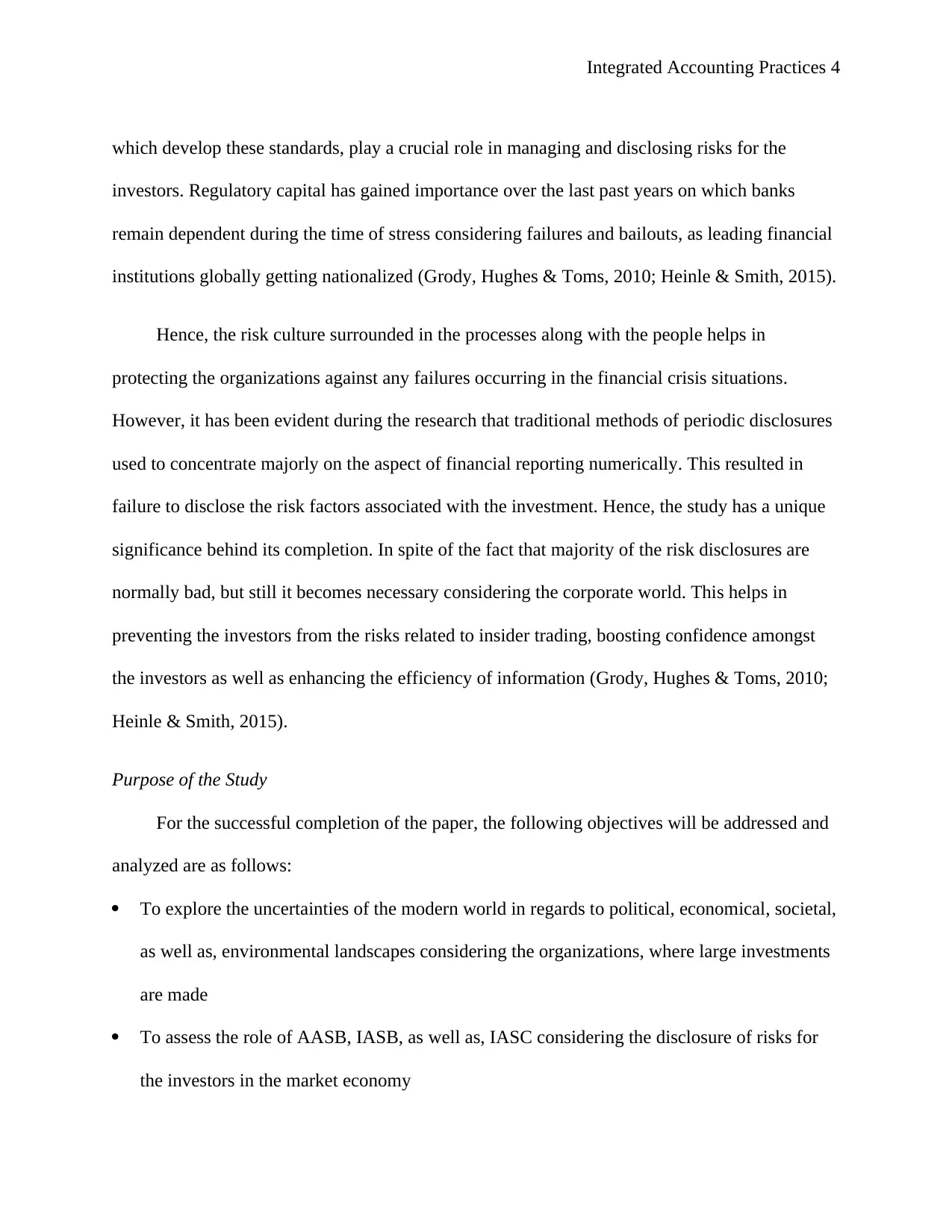
Integrated Accounting Practices 4
which develop these standards, play a crucial role in managing and disclosing risks for the
investors. Regulatory capital has gained importance over the last past years on which banks
remain dependent during the time of stress considering failures and bailouts, as leading financial
institutions globally getting nationalized (Grody, Hughes & Toms, 2010; Heinle & Smith, 2015).
Hence, the risk culture surrounded in the processes along with the people helps in
protecting the organizations against any failures occurring in the financial crisis situations.
However, it has been evident during the research that traditional methods of periodic disclosures
used to concentrate majorly on the aspect of financial reporting numerically. This resulted in
failure to disclose the risk factors associated with the investment. Hence, the study has a unique
significance behind its completion. In spite of the fact that majority of the risk disclosures are
normally bad, but still it becomes necessary considering the corporate world. This helps in
preventing the investors from the risks related to insider trading, boosting confidence amongst
the investors as well as enhancing the efficiency of information (Grody, Hughes & Toms, 2010;
Heinle & Smith, 2015).
Purpose of the Study
For the successful completion of the paper, the following objectives will be addressed and
analyzed are as follows:
To explore the uncertainties of the modern world in regards to political, economical, societal,
as well as, environmental landscapes considering the organizations, where large investments
are made
To assess the role of AASB, IASB, as well as, IASC considering the disclosure of risks for
the investors in the market economy
which develop these standards, play a crucial role in managing and disclosing risks for the
investors. Regulatory capital has gained importance over the last past years on which banks
remain dependent during the time of stress considering failures and bailouts, as leading financial
institutions globally getting nationalized (Grody, Hughes & Toms, 2010; Heinle & Smith, 2015).
Hence, the risk culture surrounded in the processes along with the people helps in
protecting the organizations against any failures occurring in the financial crisis situations.
However, it has been evident during the research that traditional methods of periodic disclosures
used to concentrate majorly on the aspect of financial reporting numerically. This resulted in
failure to disclose the risk factors associated with the investment. Hence, the study has a unique
significance behind its completion. In spite of the fact that majority of the risk disclosures are
normally bad, but still it becomes necessary considering the corporate world. This helps in
preventing the investors from the risks related to insider trading, boosting confidence amongst
the investors as well as enhancing the efficiency of information (Grody, Hughes & Toms, 2010;
Heinle & Smith, 2015).
Purpose of the Study
For the successful completion of the paper, the following objectives will be addressed and
analyzed are as follows:
To explore the uncertainties of the modern world in regards to political, economical, societal,
as well as, environmental landscapes considering the organizations, where large investments
are made
To assess the role of AASB, IASB, as well as, IASC considering the disclosure of risks for
the investors in the market economy
Paraphrase This Document
Need a fresh take? Get an instant paraphrase of this document with our AI Paraphraser
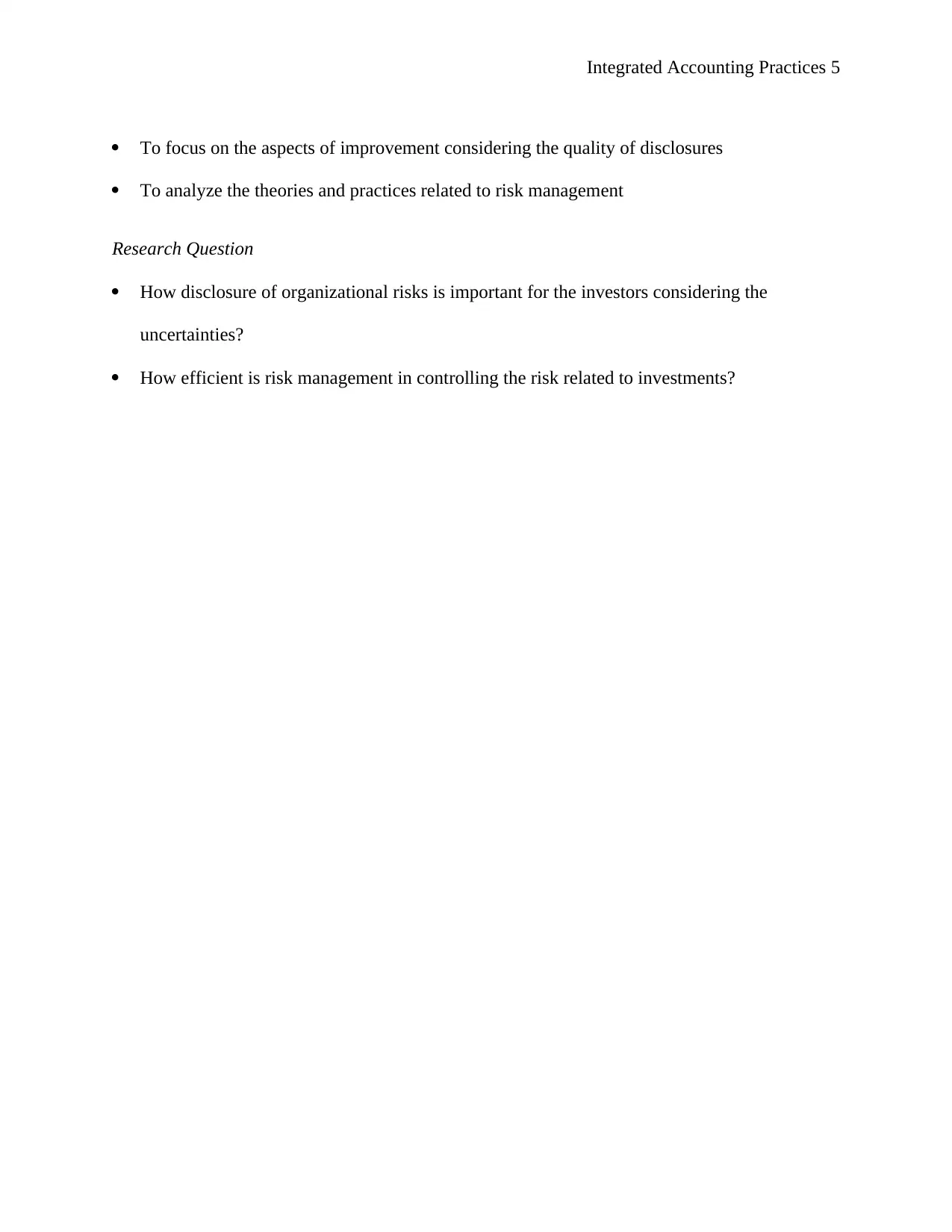
Integrated Accounting Practices 5
To focus on the aspects of improvement considering the quality of disclosures
To analyze the theories and practices related to risk management
Research Question
How disclosure of organizational risks is important for the investors considering the
uncertainties?
How efficient is risk management in controlling the risk related to investments?
To focus on the aspects of improvement considering the quality of disclosures
To analyze the theories and practices related to risk management
Research Question
How disclosure of organizational risks is important for the investors considering the
uncertainties?
How efficient is risk management in controlling the risk related to investments?
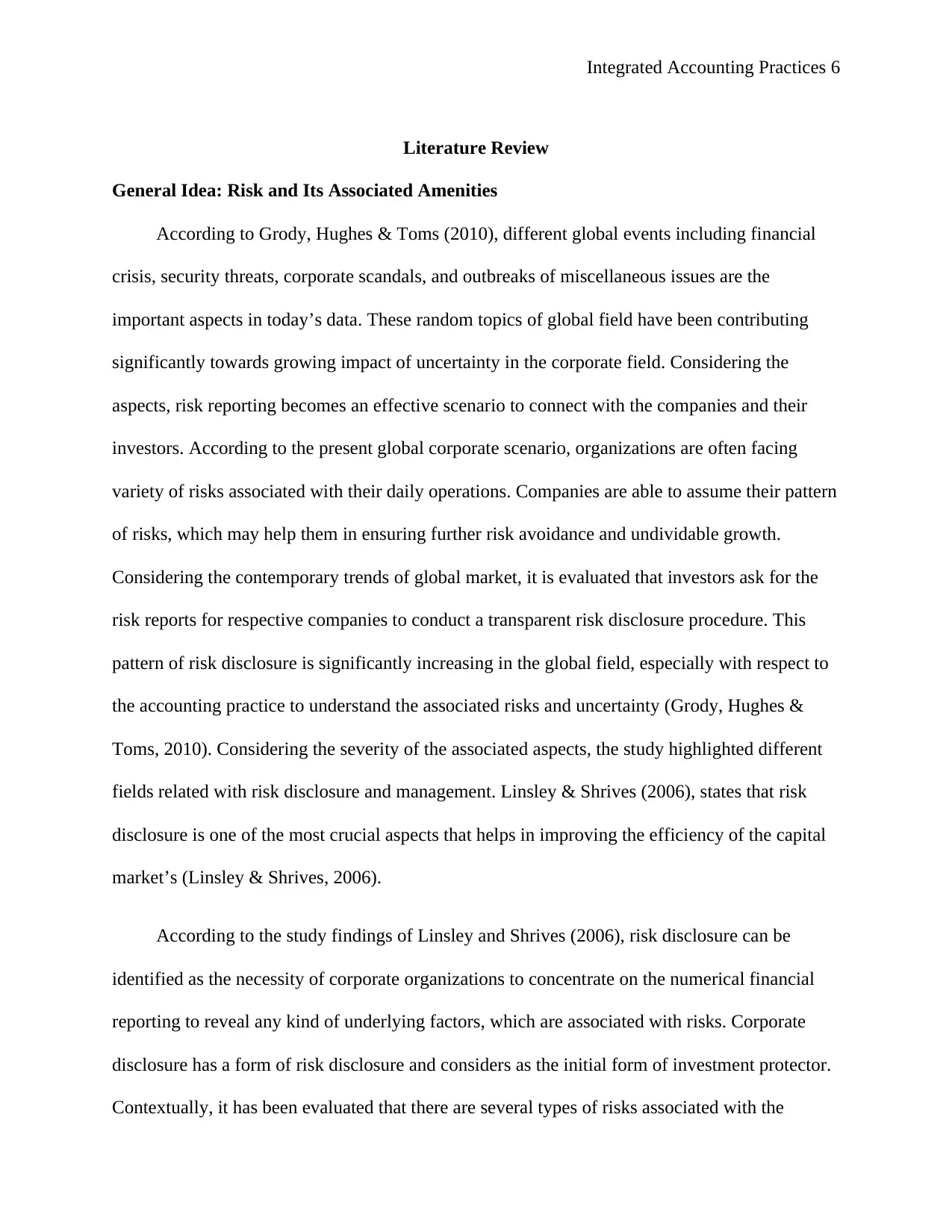
Integrated Accounting Practices 6
Literature Review
General Idea: Risk and Its Associated Amenities
According to Grody, Hughes & Toms (2010), different global events including financial
crisis, security threats, corporate scandals, and outbreaks of miscellaneous issues are the
important aspects in today’s data. These random topics of global field have been contributing
significantly towards growing impact of uncertainty in the corporate field. Considering the
aspects, risk reporting becomes an effective scenario to connect with the companies and their
investors. According to the present global corporate scenario, organizations are often facing
variety of risks associated with their daily operations. Companies are able to assume their pattern
of risks, which may help them in ensuring further risk avoidance and undividable growth.
Considering the contemporary trends of global market, it is evaluated that investors ask for the
risk reports for respective companies to conduct a transparent risk disclosure procedure. This
pattern of risk disclosure is significantly increasing in the global field, especially with respect to
the accounting practice to understand the associated risks and uncertainty (Grody, Hughes &
Toms, 2010). Considering the severity of the associated aspects, the study highlighted different
fields related with risk disclosure and management. Linsley & Shrives (2006), states that risk
disclosure is one of the most crucial aspects that helps in improving the efficiency of the capital
market’s (Linsley & Shrives, 2006).
According to the study findings of Linsley and Shrives (2006), risk disclosure can be
identified as the necessity of corporate organizations to concentrate on the numerical financial
reporting to reveal any kind of underlying factors, which are associated with risks. Corporate
disclosure has a form of risk disclosure and considers as the initial form of investment protector.
Contextually, it has been evaluated that there are several types of risks associated with the
Literature Review
General Idea: Risk and Its Associated Amenities
According to Grody, Hughes & Toms (2010), different global events including financial
crisis, security threats, corporate scandals, and outbreaks of miscellaneous issues are the
important aspects in today’s data. These random topics of global field have been contributing
significantly towards growing impact of uncertainty in the corporate field. Considering the
aspects, risk reporting becomes an effective scenario to connect with the companies and their
investors. According to the present global corporate scenario, organizations are often facing
variety of risks associated with their daily operations. Companies are able to assume their pattern
of risks, which may help them in ensuring further risk avoidance and undividable growth.
Considering the contemporary trends of global market, it is evaluated that investors ask for the
risk reports for respective companies to conduct a transparent risk disclosure procedure. This
pattern of risk disclosure is significantly increasing in the global field, especially with respect to
the accounting practice to understand the associated risks and uncertainty (Grody, Hughes &
Toms, 2010). Considering the severity of the associated aspects, the study highlighted different
fields related with risk disclosure and management. Linsley & Shrives (2006), states that risk
disclosure is one of the most crucial aspects that helps in improving the efficiency of the capital
market’s (Linsley & Shrives, 2006).
According to the study findings of Linsley and Shrives (2006), risk disclosure can be
identified as the necessity of corporate organizations to concentrate on the numerical financial
reporting to reveal any kind of underlying factors, which are associated with risks. Corporate
disclosure has a form of risk disclosure and considers as the initial form of investment protector.
Contextually, it has been evaluated that there are several types of risks associated with the
⊘ This is a preview!⊘
Do you want full access?
Subscribe today to unlock all pages.

Trusted by 1+ million students worldwide
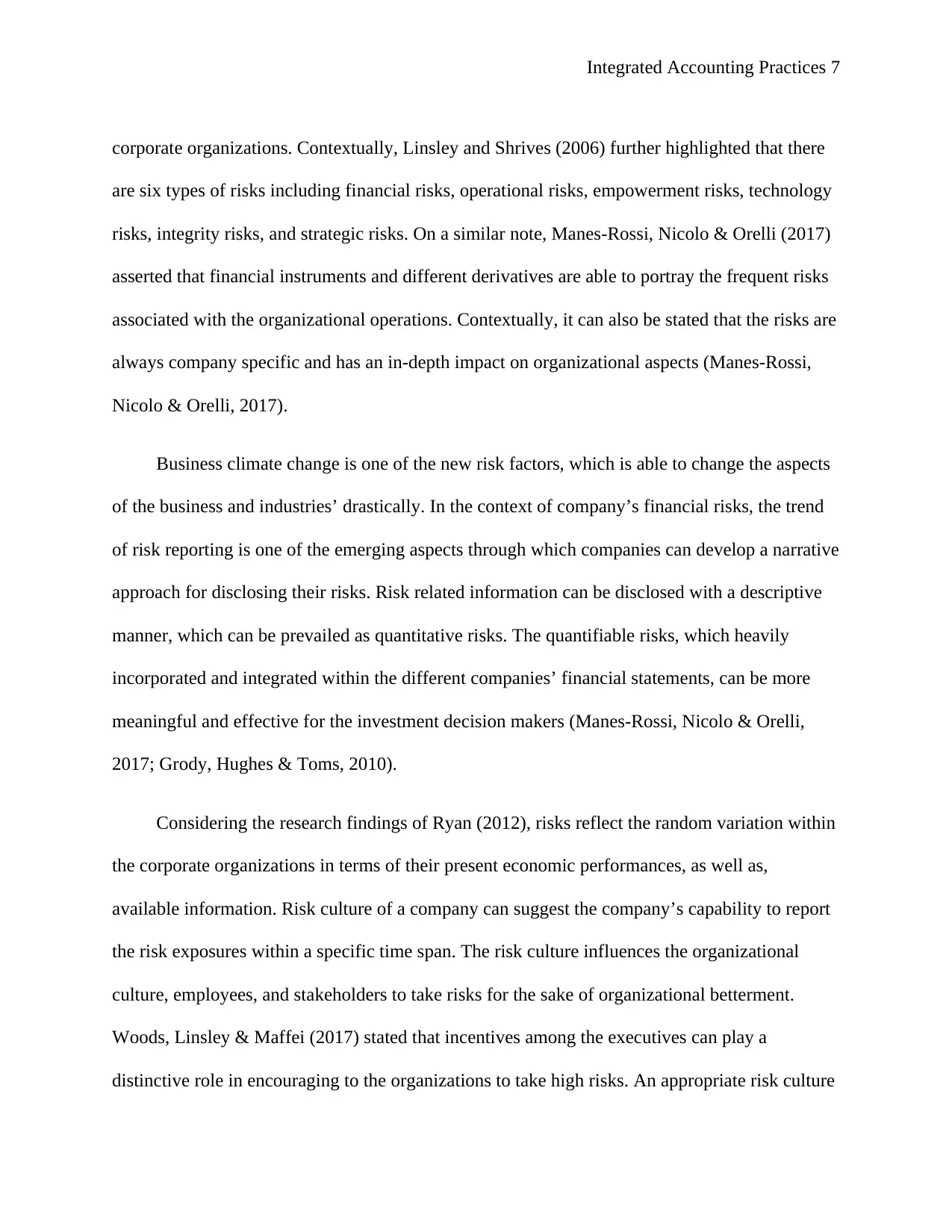
Integrated Accounting Practices 7
corporate organizations. Contextually, Linsley and Shrives (2006) further highlighted that there
are six types of risks including financial risks, operational risks, empowerment risks, technology
risks, integrity risks, and strategic risks. On a similar note, Manes-Rossi, Nicolo & Orelli (2017)
asserted that financial instruments and different derivatives are able to portray the frequent risks
associated with the organizational operations. Contextually, it can also be stated that the risks are
always company specific and has an in-depth impact on organizational aspects (Manes-Rossi,
Nicolo & Orelli, 2017).
Business climate change is one of the new risk factors, which is able to change the aspects
of the business and industries’ drastically. In the context of company’s financial risks, the trend
of risk reporting is one of the emerging aspects through which companies can develop a narrative
approach for disclosing their risks. Risk related information can be disclosed with a descriptive
manner, which can be prevailed as quantitative risks. The quantifiable risks, which heavily
incorporated and integrated within the different companies’ financial statements, can be more
meaningful and effective for the investment decision makers (Manes-Rossi, Nicolo & Orelli,
2017; Grody, Hughes & Toms, 2010).
Considering the research findings of Ryan (2012), risks reflect the random variation within
the corporate organizations in terms of their present economic performances, as well as,
available information. Risk culture of a company can suggest the company’s capability to report
the risk exposures within a specific time span. The risk culture influences the organizational
culture, employees, and stakeholders to take risks for the sake of organizational betterment.
Woods, Linsley & Maffei (2017) stated that incentives among the executives can play a
distinctive role in encouraging to the organizations to take high risks. An appropriate risk culture
corporate organizations. Contextually, Linsley and Shrives (2006) further highlighted that there
are six types of risks including financial risks, operational risks, empowerment risks, technology
risks, integrity risks, and strategic risks. On a similar note, Manes-Rossi, Nicolo & Orelli (2017)
asserted that financial instruments and different derivatives are able to portray the frequent risks
associated with the organizational operations. Contextually, it can also be stated that the risks are
always company specific and has an in-depth impact on organizational aspects (Manes-Rossi,
Nicolo & Orelli, 2017).
Business climate change is one of the new risk factors, which is able to change the aspects
of the business and industries’ drastically. In the context of company’s financial risks, the trend
of risk reporting is one of the emerging aspects through which companies can develop a narrative
approach for disclosing their risks. Risk related information can be disclosed with a descriptive
manner, which can be prevailed as quantitative risks. The quantifiable risks, which heavily
incorporated and integrated within the different companies’ financial statements, can be more
meaningful and effective for the investment decision makers (Manes-Rossi, Nicolo & Orelli,
2017; Grody, Hughes & Toms, 2010).
Considering the research findings of Ryan (2012), risks reflect the random variation within
the corporate organizations in terms of their present economic performances, as well as,
available information. Risk culture of a company can suggest the company’s capability to report
the risk exposures within a specific time span. The risk culture influences the organizational
culture, employees, and stakeholders to take risks for the sake of organizational betterment.
Woods, Linsley & Maffei (2017) stated that incentives among the executives can play a
distinctive role in encouraging to the organizations to take high risks. An appropriate risk culture
Paraphrase This Document
Need a fresh take? Get an instant paraphrase of this document with our AI Paraphraser
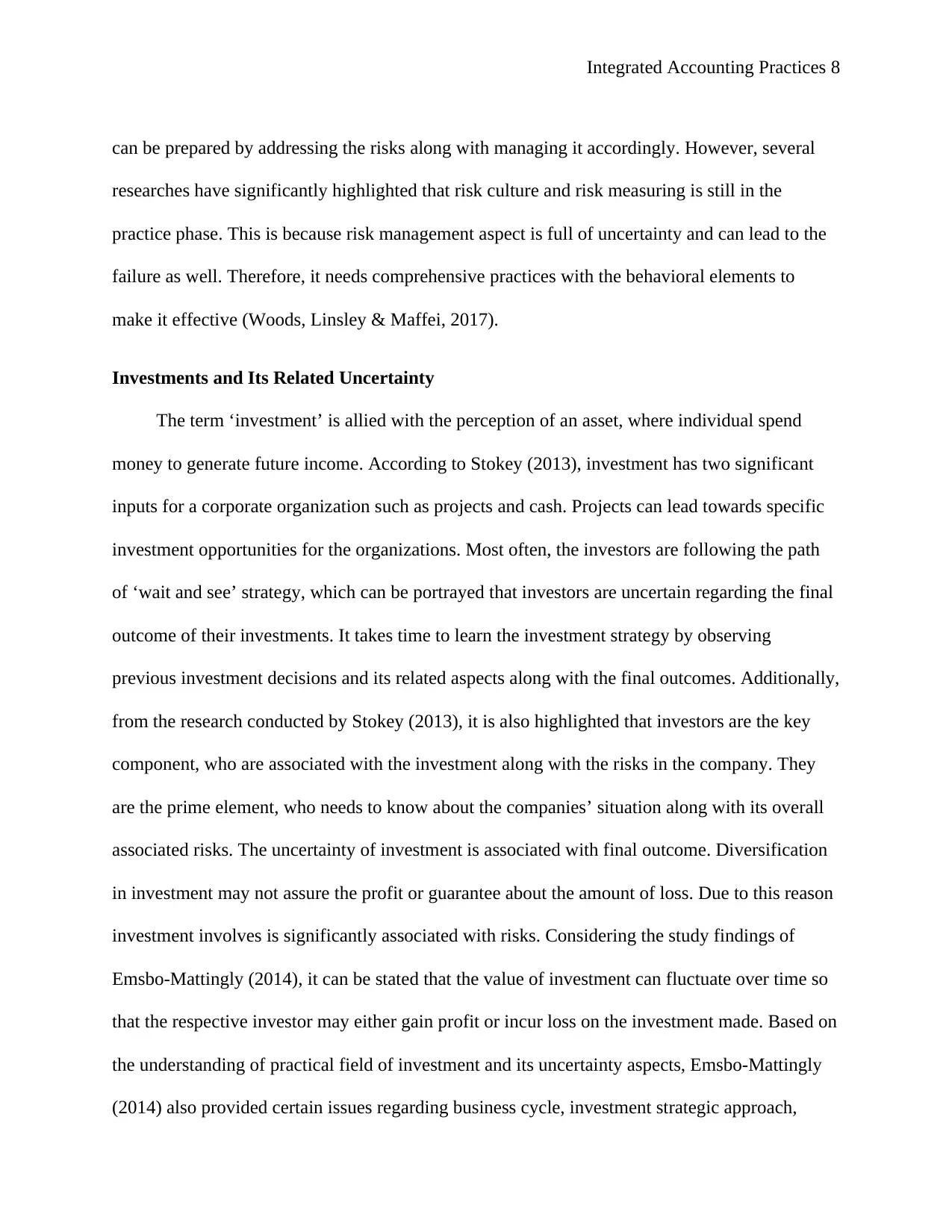
Integrated Accounting Practices 8
can be prepared by addressing the risks along with managing it accordingly. However, several
researches have significantly highlighted that risk culture and risk measuring is still in the
practice phase. This is because risk management aspect is full of uncertainty and can lead to the
failure as well. Therefore, it needs comprehensive practices with the behavioral elements to
make it effective (Woods, Linsley & Maffei, 2017).
Investments and Its Related Uncertainty
The term ‘investment’ is allied with the perception of an asset, where individual spend
money to generate future income. According to Stokey (2013), investment has two significant
inputs for a corporate organization such as projects and cash. Projects can lead towards specific
investment opportunities for the organizations. Most often, the investors are following the path
of ‘wait and see’ strategy, which can be portrayed that investors are uncertain regarding the final
outcome of their investments. It takes time to learn the investment strategy by observing
previous investment decisions and its related aspects along with the final outcomes. Additionally,
from the research conducted by Stokey (2013), it is also highlighted that investors are the key
component, who are associated with the investment along with the risks in the company. They
are the prime element, who needs to know about the companies’ situation along with its overall
associated risks. The uncertainty of investment is associated with final outcome. Diversification
in investment may not assure the profit or guarantee about the amount of loss. Due to this reason
investment involves is significantly associated with risks. Considering the study findings of
Emsbo-Mattingly (2014), it can be stated that the value of investment can fluctuate over time so
that the respective investor may either gain profit or incur loss on the investment made. Based on
the understanding of practical field of investment and its uncertainty aspects, Emsbo-Mattingly
(2014) also provided certain issues regarding business cycle, investment strategic approach,
can be prepared by addressing the risks along with managing it accordingly. However, several
researches have significantly highlighted that risk culture and risk measuring is still in the
practice phase. This is because risk management aspect is full of uncertainty and can lead to the
failure as well. Therefore, it needs comprehensive practices with the behavioral elements to
make it effective (Woods, Linsley & Maffei, 2017).
Investments and Its Related Uncertainty
The term ‘investment’ is allied with the perception of an asset, where individual spend
money to generate future income. According to Stokey (2013), investment has two significant
inputs for a corporate organization such as projects and cash. Projects can lead towards specific
investment opportunities for the organizations. Most often, the investors are following the path
of ‘wait and see’ strategy, which can be portrayed that investors are uncertain regarding the final
outcome of their investments. It takes time to learn the investment strategy by observing
previous investment decisions and its related aspects along with the final outcomes. Additionally,
from the research conducted by Stokey (2013), it is also highlighted that investors are the key
component, who are associated with the investment along with the risks in the company. They
are the prime element, who needs to know about the companies’ situation along with its overall
associated risks. The uncertainty of investment is associated with final outcome. Diversification
in investment may not assure the profit or guarantee about the amount of loss. Due to this reason
investment involves is significantly associated with risks. Considering the study findings of
Emsbo-Mattingly (2014), it can be stated that the value of investment can fluctuate over time so
that the respective investor may either gain profit or incur loss on the investment made. Based on
the understanding of practical field of investment and its uncertainty aspects, Emsbo-Mattingly
(2014) also provided certain issues regarding business cycle, investment strategic approach,
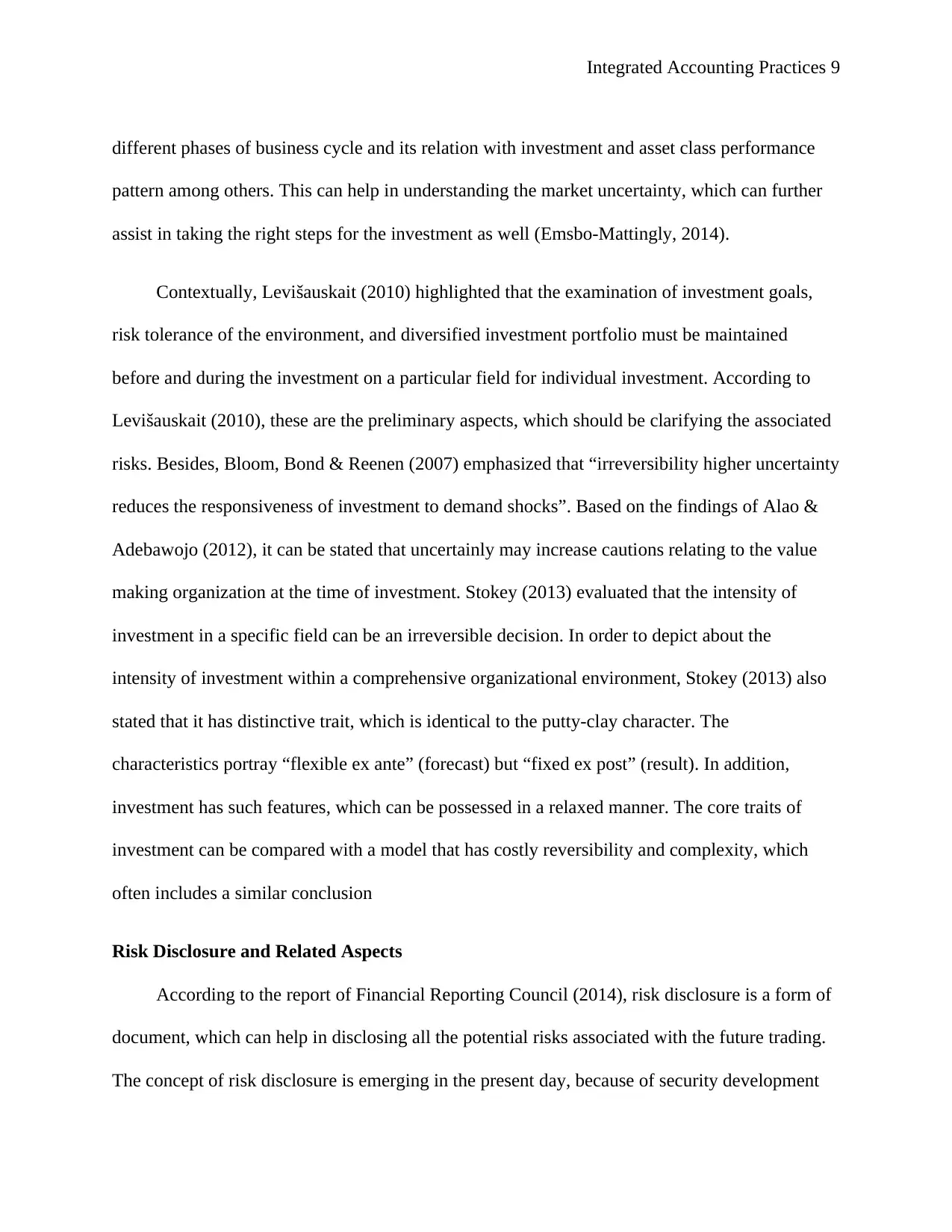
Integrated Accounting Practices 9
different phases of business cycle and its relation with investment and asset class performance
pattern among others. This can help in understanding the market uncertainty, which can further
assist in taking the right steps for the investment as well (Emsbo-Mattingly, 2014).
Contextually, Levišauskait (2010) highlighted that the examination of investment goals,
risk tolerance of the environment, and diversified investment portfolio must be maintained
before and during the investment on a particular field for individual investment. According to
Levišauskait (2010), these are the preliminary aspects, which should be clarifying the associated
risks. Besides, Bloom, Bond & Reenen (2007) emphasized that “irreversibility higher uncertainty
reduces the responsiveness of investment to demand shocks”. Based on the findings of Alao &
Adebawojo (2012), it can be stated that uncertainly may increase cautions relating to the value
making organization at the time of investment. Stokey (2013) evaluated that the intensity of
investment in a specific field can be an irreversible decision. In order to depict about the
intensity of investment within a comprehensive organizational environment, Stokey (2013) also
stated that it has distinctive trait, which is identical to the putty-clay character. The
characteristics portray “flexible ex ante” (forecast) but “fixed ex post” (result). In addition,
investment has such features, which can be possessed in a relaxed manner. The core traits of
investment can be compared with a model that has costly reversibility and complexity, which
often includes a similar conclusion
Risk Disclosure and Related Aspects
According to the report of Financial Reporting Council (2014), risk disclosure is a form of
document, which can help in disclosing all the potential risks associated with the future trading.
The concept of risk disclosure is emerging in the present day, because of security development
different phases of business cycle and its relation with investment and asset class performance
pattern among others. This can help in understanding the market uncertainty, which can further
assist in taking the right steps for the investment as well (Emsbo-Mattingly, 2014).
Contextually, Levišauskait (2010) highlighted that the examination of investment goals,
risk tolerance of the environment, and diversified investment portfolio must be maintained
before and during the investment on a particular field for individual investment. According to
Levišauskait (2010), these are the preliminary aspects, which should be clarifying the associated
risks. Besides, Bloom, Bond & Reenen (2007) emphasized that “irreversibility higher uncertainty
reduces the responsiveness of investment to demand shocks”. Based on the findings of Alao &
Adebawojo (2012), it can be stated that uncertainly may increase cautions relating to the value
making organization at the time of investment. Stokey (2013) evaluated that the intensity of
investment in a specific field can be an irreversible decision. In order to depict about the
intensity of investment within a comprehensive organizational environment, Stokey (2013) also
stated that it has distinctive trait, which is identical to the putty-clay character. The
characteristics portray “flexible ex ante” (forecast) but “fixed ex post” (result). In addition,
investment has such features, which can be possessed in a relaxed manner. The core traits of
investment can be compared with a model that has costly reversibility and complexity, which
often includes a similar conclusion
Risk Disclosure and Related Aspects
According to the report of Financial Reporting Council (2014), risk disclosure is a form of
document, which can help in disclosing all the potential risks associated with the future trading.
The concept of risk disclosure is emerging in the present day, because of security development
⊘ This is a preview!⊘
Do you want full access?
Subscribe today to unlock all pages.

Trusted by 1+ million students worldwide
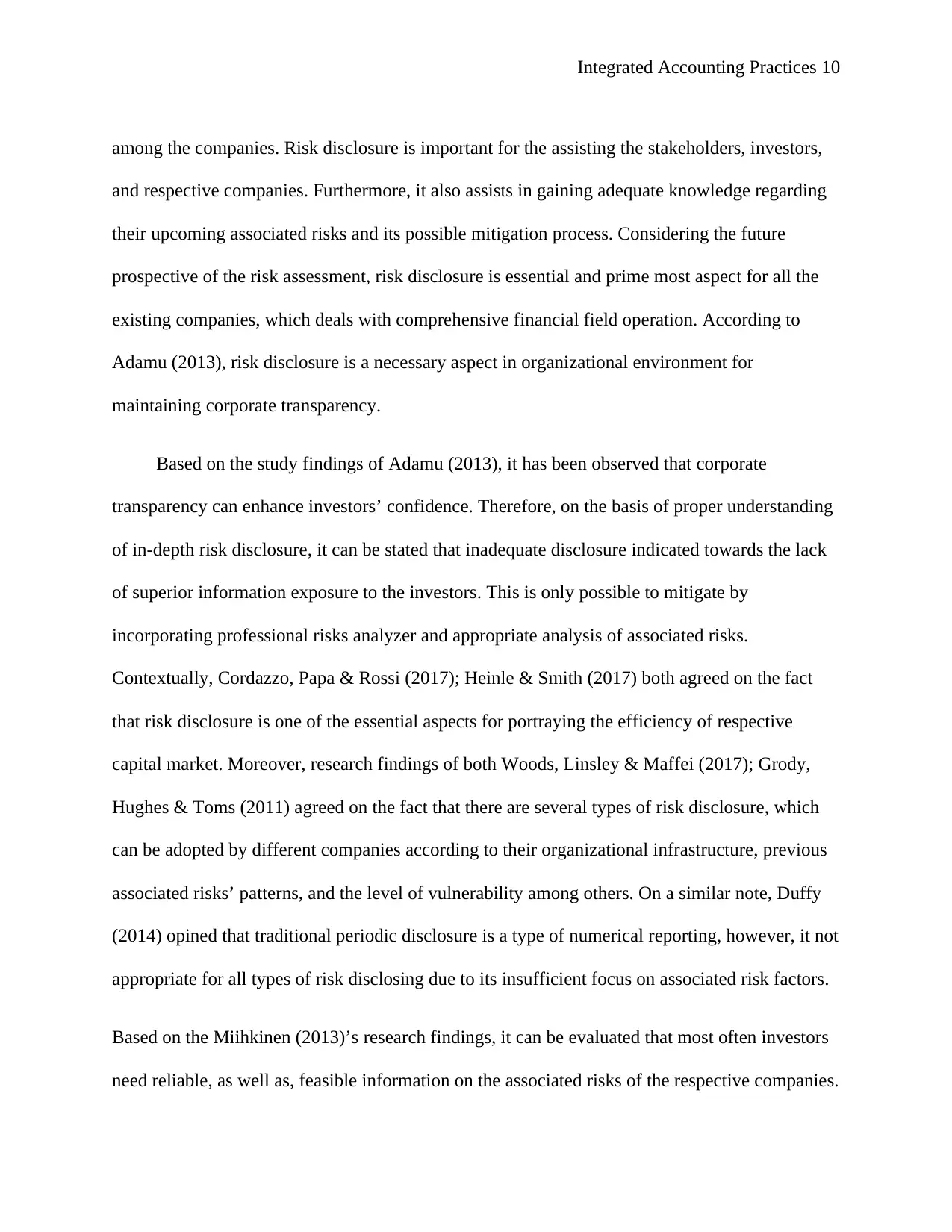
Integrated Accounting Practices 10
among the companies. Risk disclosure is important for the assisting the stakeholders, investors,
and respective companies. Furthermore, it also assists in gaining adequate knowledge regarding
their upcoming associated risks and its possible mitigation process. Considering the future
prospective of the risk assessment, risk disclosure is essential and prime most aspect for all the
existing companies, which deals with comprehensive financial field operation. According to
Adamu (2013), risk disclosure is a necessary aspect in organizational environment for
maintaining corporate transparency.
Based on the study findings of Adamu (2013), it has been observed that corporate
transparency can enhance investors’ confidence. Therefore, on the basis of proper understanding
of in-depth risk disclosure, it can be stated that inadequate disclosure indicated towards the lack
of superior information exposure to the investors. This is only possible to mitigate by
incorporating professional risks analyzer and appropriate analysis of associated risks.
Contextually, Cordazzo, Papa & Rossi (2017); Heinle & Smith (2017) both agreed on the fact
that risk disclosure is one of the essential aspects for portraying the efficiency of respective
capital market. Moreover, research findings of both Woods, Linsley & Maffei (2017); Grody,
Hughes & Toms (2011) agreed on the fact that there are several types of risk disclosure, which
can be adopted by different companies according to their organizational infrastructure, previous
associated risks’ patterns, and the level of vulnerability among others. On a similar note, Duffy
(2014) opined that traditional periodic disclosure is a type of numerical reporting, however, it not
appropriate for all types of risk disclosing due to its insufficient focus on associated risk factors.
Based on the Miihkinen (2013)’s research findings, it can be evaluated that most often investors
need reliable, as well as, feasible information on the associated risks of the respective companies.
among the companies. Risk disclosure is important for the assisting the stakeholders, investors,
and respective companies. Furthermore, it also assists in gaining adequate knowledge regarding
their upcoming associated risks and its possible mitigation process. Considering the future
prospective of the risk assessment, risk disclosure is essential and prime most aspect for all the
existing companies, which deals with comprehensive financial field operation. According to
Adamu (2013), risk disclosure is a necessary aspect in organizational environment for
maintaining corporate transparency.
Based on the study findings of Adamu (2013), it has been observed that corporate
transparency can enhance investors’ confidence. Therefore, on the basis of proper understanding
of in-depth risk disclosure, it can be stated that inadequate disclosure indicated towards the lack
of superior information exposure to the investors. This is only possible to mitigate by
incorporating professional risks analyzer and appropriate analysis of associated risks.
Contextually, Cordazzo, Papa & Rossi (2017); Heinle & Smith (2017) both agreed on the fact
that risk disclosure is one of the essential aspects for portraying the efficiency of respective
capital market. Moreover, research findings of both Woods, Linsley & Maffei (2017); Grody,
Hughes & Toms (2011) agreed on the fact that there are several types of risk disclosure, which
can be adopted by different companies according to their organizational infrastructure, previous
associated risks’ patterns, and the level of vulnerability among others. On a similar note, Duffy
(2014) opined that traditional periodic disclosure is a type of numerical reporting, however, it not
appropriate for all types of risk disclosing due to its insufficient focus on associated risk factors.
Based on the Miihkinen (2013)’s research findings, it can be evaluated that most often investors
need reliable, as well as, feasible information on the associated risks of the respective companies.
Paraphrase This Document
Need a fresh take? Get an instant paraphrase of this document with our AI Paraphraser
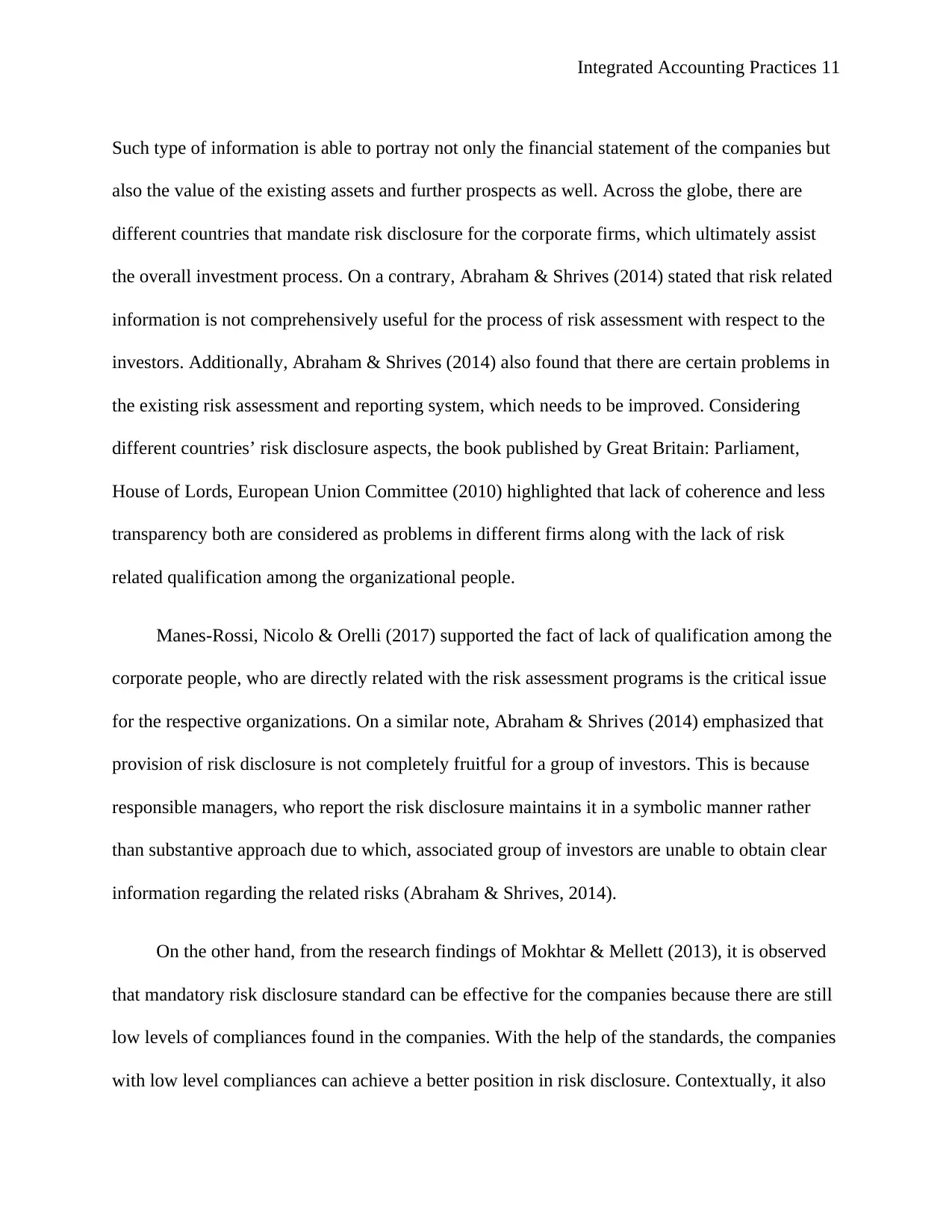
Integrated Accounting Practices 11
Such type of information is able to portray not only the financial statement of the companies but
also the value of the existing assets and further prospects as well. Across the globe, there are
different countries that mandate risk disclosure for the corporate firms, which ultimately assist
the overall investment process. On a contrary, Abraham & Shrives (2014) stated that risk related
information is not comprehensively useful for the process of risk assessment with respect to the
investors. Additionally, Abraham & Shrives (2014) also found that there are certain problems in
the existing risk assessment and reporting system, which needs to be improved. Considering
different countries’ risk disclosure aspects, the book published by Great Britain: Parliament,
House of Lords, European Union Committee (2010) highlighted that lack of coherence and less
transparency both are considered as problems in different firms along with the lack of risk
related qualification among the organizational people.
Manes-Rossi, Nicolo & Orelli (2017) supported the fact of lack of qualification among the
corporate people, who are directly related with the risk assessment programs is the critical issue
for the respective organizations. On a similar note, Abraham & Shrives (2014) emphasized that
provision of risk disclosure is not completely fruitful for a group of investors. This is because
responsible managers, who report the risk disclosure maintains it in a symbolic manner rather
than substantive approach due to which, associated group of investors are unable to obtain clear
information regarding the related risks (Abraham & Shrives, 2014).
On the other hand, from the research findings of Mokhtar & Mellett (2013), it is observed
that mandatory risk disclosure standard can be effective for the companies because there are still
low levels of compliances found in the companies. With the help of the standards, the companies
with low level compliances can achieve a better position in risk disclosure. Contextually, it also
Such type of information is able to portray not only the financial statement of the companies but
also the value of the existing assets and further prospects as well. Across the globe, there are
different countries that mandate risk disclosure for the corporate firms, which ultimately assist
the overall investment process. On a contrary, Abraham & Shrives (2014) stated that risk related
information is not comprehensively useful for the process of risk assessment with respect to the
investors. Additionally, Abraham & Shrives (2014) also found that there are certain problems in
the existing risk assessment and reporting system, which needs to be improved. Considering
different countries’ risk disclosure aspects, the book published by Great Britain: Parliament,
House of Lords, European Union Committee (2010) highlighted that lack of coherence and less
transparency both are considered as problems in different firms along with the lack of risk
related qualification among the organizational people.
Manes-Rossi, Nicolo & Orelli (2017) supported the fact of lack of qualification among the
corporate people, who are directly related with the risk assessment programs is the critical issue
for the respective organizations. On a similar note, Abraham & Shrives (2014) emphasized that
provision of risk disclosure is not completely fruitful for a group of investors. This is because
responsible managers, who report the risk disclosure maintains it in a symbolic manner rather
than substantive approach due to which, associated group of investors are unable to obtain clear
information regarding the related risks (Abraham & Shrives, 2014).
On the other hand, from the research findings of Mokhtar & Mellett (2013), it is observed
that mandatory risk disclosure standard can be effective for the companies because there are still
low levels of compliances found in the companies. With the help of the standards, the companies
with low level compliances can achieve a better position in risk disclosure. Contextually, it also
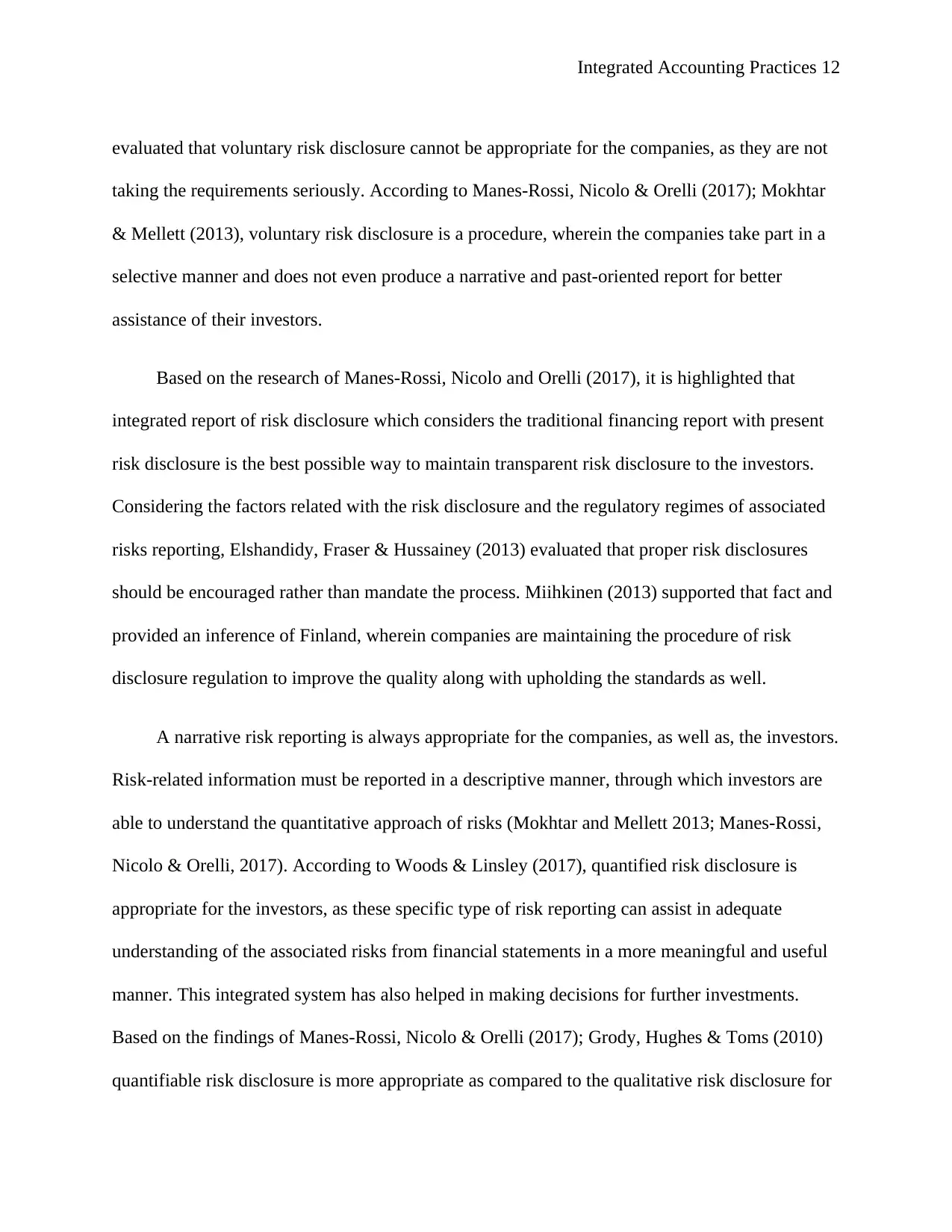
Integrated Accounting Practices 12
evaluated that voluntary risk disclosure cannot be appropriate for the companies, as they are not
taking the requirements seriously. According to Manes-Rossi, Nicolo & Orelli (2017); Mokhtar
& Mellett (2013), voluntary risk disclosure is a procedure, wherein the companies take part in a
selective manner and does not even produce a narrative and past-oriented report for better
assistance of their investors.
Based on the research of Manes-Rossi, Nicolo and Orelli (2017), it is highlighted that
integrated report of risk disclosure which considers the traditional financing report with present
risk disclosure is the best possible way to maintain transparent risk disclosure to the investors.
Considering the factors related with the risk disclosure and the regulatory regimes of associated
risks reporting, Elshandidy, Fraser & Hussainey (2013) evaluated that proper risk disclosures
should be encouraged rather than mandate the process. Miihkinen (2013) supported that fact and
provided an inference of Finland, wherein companies are maintaining the procedure of risk
disclosure regulation to improve the quality along with upholding the standards as well.
A narrative risk reporting is always appropriate for the companies, as well as, the investors.
Risk-related information must be reported in a descriptive manner, through which investors are
able to understand the quantitative approach of risks (Mokhtar and Mellett 2013; Manes-Rossi,
Nicolo & Orelli, 2017). According to Woods & Linsley (2017), quantified risk disclosure is
appropriate for the investors, as these specific type of risk reporting can assist in adequate
understanding of the associated risks from financial statements in a more meaningful and useful
manner. This integrated system has also helped in making decisions for further investments.
Based on the findings of Manes-Rossi, Nicolo & Orelli (2017); Grody, Hughes & Toms (2010)
quantifiable risk disclosure is more appropriate as compared to the qualitative risk disclosure for
evaluated that voluntary risk disclosure cannot be appropriate for the companies, as they are not
taking the requirements seriously. According to Manes-Rossi, Nicolo & Orelli (2017); Mokhtar
& Mellett (2013), voluntary risk disclosure is a procedure, wherein the companies take part in a
selective manner and does not even produce a narrative and past-oriented report for better
assistance of their investors.
Based on the research of Manes-Rossi, Nicolo and Orelli (2017), it is highlighted that
integrated report of risk disclosure which considers the traditional financing report with present
risk disclosure is the best possible way to maintain transparent risk disclosure to the investors.
Considering the factors related with the risk disclosure and the regulatory regimes of associated
risks reporting, Elshandidy, Fraser & Hussainey (2013) evaluated that proper risk disclosures
should be encouraged rather than mandate the process. Miihkinen (2013) supported that fact and
provided an inference of Finland, wherein companies are maintaining the procedure of risk
disclosure regulation to improve the quality along with upholding the standards as well.
A narrative risk reporting is always appropriate for the companies, as well as, the investors.
Risk-related information must be reported in a descriptive manner, through which investors are
able to understand the quantitative approach of risks (Mokhtar and Mellett 2013; Manes-Rossi,
Nicolo & Orelli, 2017). According to Woods & Linsley (2017), quantified risk disclosure is
appropriate for the investors, as these specific type of risk reporting can assist in adequate
understanding of the associated risks from financial statements in a more meaningful and useful
manner. This integrated system has also helped in making decisions for further investments.
Based on the findings of Manes-Rossi, Nicolo & Orelli (2017); Grody, Hughes & Toms (2010)
quantifiable risk disclosure is more appropriate as compared to the qualitative risk disclosure for
⊘ This is a preview!⊘
Do you want full access?
Subscribe today to unlock all pages.

Trusted by 1+ million students worldwide
1 out of 30
Related Documents
Your All-in-One AI-Powered Toolkit for Academic Success.
+13062052269
info@desklib.com
Available 24*7 on WhatsApp / Email
![[object Object]](/_next/static/media/star-bottom.7253800d.svg)
Unlock your academic potential
Copyright © 2020–2025 A2Z Services. All Rights Reserved. Developed and managed by ZUCOL.





